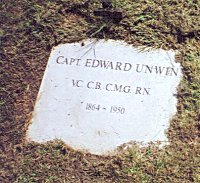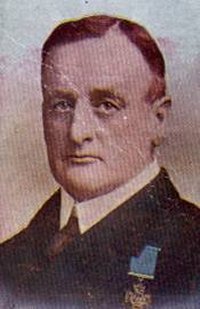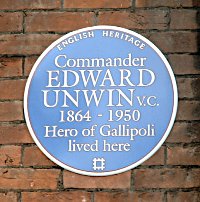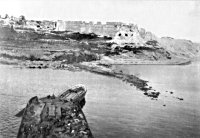
Portrait

Blue Plaque

View From HMS River Clyde

Location of Grave:
St Luke's Churchyard, Grayshot, Surrey
Gravestone erected, South West of the Church Porch (1995)
EDWARD UNWIN, V.C.
CAPTAIN
ROYAL NAVY
MEDAL WON: V BEACH, GALLIPOLI, TURKEY, 25 APRIL 1915
GAZETTED: 16 AUGUST 1915
BORN: 17 MAR 1864 at FOREST LODGE, FAWLEY, HYTHE, HAMPSHIRE
DIED: 19 APR 1950, GREYSHOT VILLAGE
MEDAL: ON LOAN TO THE IMPERIAL WAR MUSEUM
Details of the Award
While in River Clyde observing that the lighters were to form a bridge to the shore had broken adrift, Commander Unwin left the ship and under murderous fire attempted, to get the lighters into position. He worked on until, suffering from the effects of cold and immersion, he was obliged to return to the ship, where he was wrapped up in blankets. Having to some degree recovered, he returned to his work against the doctor's orders and completed it. He was later again attended by the doctor for three abrasions caused by bullets, after he once more left the ship, this time in a life-boat, to save some wounded men who were lying in the shallow water near the beach. He continued his heroic labour under continuous fire, until forced to stop through pure physical exhaustion
Portsmouth Connections
From 1903-1905 Unwin rented a house in Clifton Terrace before moving to 12 Helena Road, Southsea where he lived until 1912. English Heritage have placed a blue plaque at this address.
At a special meeting of Portsmouth Council on Thursday November 16th, 1916 Captain Unwin was presented with an Address by the Mayor of Portsmouth (Councillor H.R. Pink) in the Council Chambers at the Town Hall. It was enclosed in a silver gilt casket provided from the fund originated by Mr F J Privett and carried through by the Evening News. The address read as follows:
"To Captain Edward Unwin V.C., R.N., We, the Mayor, Aldermen and Burgesses of the County Borough of Portsmouth beg to extend to you an expression of our cordial congratulations on the occasion of the distinguished order of the Victoria Cross being conferred upon you by His Majesty the King for great gallantry during the landing on the Gallipoli Peninsula under a murderous fire, of British Troops from HMS "Clyde," and for the bravery in rescuing wounded men from the water. We are proud to record that you have been for many years a burgess of this, the First Naval Port of the British Empire, and we tender to you, your wife and family, our sincere good wishes for your future health and happiness"
Further Information
The Landing from the "River Clyde"
Among all the events of that glorious day on which the allied armies disembarked on the Gallipoli peninsula, the most striking from a naval point of view was that of the landing from the steamer River Clyde. Our service was so splendidly by Officers, Petty Officers and men who took part in it that it is an episode which must not be forgotten and must occupy for all time a glorious place in our naval history.
It was anticipated that the landing on "V" beach would be the most difficult of all for the coast here possesses great advantages for defence. The position forms a natural amphitheatre with the beach as a stage. On the west side are perpendicular cliffs on the East the old castle and village of Seddul-Bahr. The whole foreshore was covered with barbed wire entanglements, extending in places below low watermark. The first landing here, as on other beaches, was to be made by boats, but in view of the difficulties to be encountered, the remainder of the covering force was to be disembarked from the steamer River Clyde.
She was to run ashore on the beach, which was here steep, thus conveying the troops right up to their objective under the shelter of the ship's plating. Regular emplacements for machine-guns and further protection was afforded by an ample supply of sandbags. The River Clyde, originally a collier, was prepared in Mudros for her work in carrying and landing 2,000 troops, under the direction of Commander E. Unwin, who was to command her during the operation. Eight ports were cut in her side, large enough to allow a fully equipped man to pass through on to a temporary gallery rigged round the ship, from stern to bow, on which were gangways by which the troops could run down to the beach, or get aboard the lighters. These latter were to form a bridge to the shore in the case the ship grounded too far out to use the gangways only.
The lighters to form the bridge were towed alongside the starboard side, while on the port side was a hopper. The hopper was self propelled and was fitted with a brow to drop on to the beach as soon as the ship took the ground. As River Clyde touched, the hopper was to go ahead, using the lighters if necessary , to bridge the gap between ship and shore. The River Clyde was manned by volunteers from Commander Unwin's own ship the Hussar; six seamen, six engine-room ratings, and a shipwright being selected from all those who came forward. "A leading seaman named Williams - writes Commander Unwin - asked if he could come. I told him I did not want a Leading Seaman: to which he replied "I'll chuck my rate if only you will let me come." And I did so to his cost, but to his everlasting glory. I shall never forget the way he died"
Immediately the first party in the boats reached the beach, Commander Unwin put the River Clyde ashore exactly as had been planned but, through a mistake, the hopper sheered off to port, the tow rope could not be cleared and she failed to go ahead as intended. Midshipman G.L. Drewry, R.N.R., who was in charge of her, aided by Lieutenant J.A.V. Morse and Midshipman W. St. A. Malleson of the Cornwallis, who came to the his assistance, exposed themselves to continuous fire, trying to get the hopper into position in order to form the connection with the beach.
Immediately the ship had touched, Commander Unwin dashed over the port side of the bridge where he saw the hopper sheering off to port, and Drewry hacking away with an axe trying to cut the tow rope. Realising that she would not be able to get into position in time to be of use, Commander Unwin went down over the starboard bow on to the lighters which had shot ahead under their own impetus. Taking a line from one of them he swam ashore and hauled the lighters towards him, assisted by A.B. Williams who had followed him. Standing up to their shoulders in water and fully exposed to the rifle and machine-gun fire of the Turkish troops, they together made some sort of connection with the beach and called on the troops to come along. As the Brigade diary records: "Thanks to the extraordinary gallantry displayed by the naval party, the barges were got into some sort of position" Nobly the soldiers responded, but owing to the severity of the fire, few reached the shore, and in a very short time, Commander Unwin and A.B. Williams, holding onto the line, were standing in a crimson sea.
After about 40 minutes of this, Williams gave a gasp and, saying a shell had struck him, fell into Commander Unwin's arms, and that officer, obliged to hold him up lest he should fall and drown, was forced to let go of the rope. The wind, being off shore, the lighters started to drift away just as Drewry, Malleson and others who had been working about the hopper came on the scene.
By this time Commander Unwin was quite spent and after he had got Williams to a place of comparative safety, he himself was removed to the River Clyde. Williams, however, had succumbed to his injuries. Midshipman Drewry and Malleson, assisted by A. B. Samson, R.N.R., set to work to restore the broken communication and with enough success to enable Drewry, as he was carried below in the River Clyde with a bullet wound on the forehead, to report to Commander Unwin "I have made the connection, Sir."
Commander Unwin was at that moment coming out of his cabin, where for an hour the Doctors had been trying to get his heart to work normally. Directly he could, he went down again into the hopper to try and improve the connection, and he tells how he was helped by an old merchant seaman whose age must have been near 70, and a boy under 18, both of whom faced the fire without hesitation. The attempt, however, had to be given up when Commander Unwin was wounded by bullet splinters in the face and was force to return to the ship for further medical treatment.
A.B. Samson distinguished himself by remaining in the lighters all day, helping with the lines as requires, and in the intervals, attending to and helping the wounded. He himself was wounded several times, but refused to give in.
The Albion, one of the ships covering the landing, sent in her launch and pinnance manned by volunteers to help form the bridge, and of their crews, Petty Officer, 2nd Class Frederick Gibson and Ordinary Seaman Jesse Lovelock particularly distinguished themselves, not only trying to get the boats into position, but also assisting to get the wounded from the beach and the lighters back into the River Clyde.
In spite of all efforts, however, the troops could never use the bridge of lighters until after dark; every man who ventured to try and cross the shore during daylight was shot down, the Turkish fire completely dominated the situation. The Brigadier-General Napier, and his Brigade Major, Costeker, were both killed in attempting to give the soldiers a lead to the shore. Under the cover of darkness, however, the landing was successfully accomplished, and the position established.
Acknowledgements
The information on this page was mostly supplied by Brandon Smith. The portrait of Unwin (from a cigarette card) and the view from HMS River Clyde are from the page to Unwin on WIKIPEDIA.

